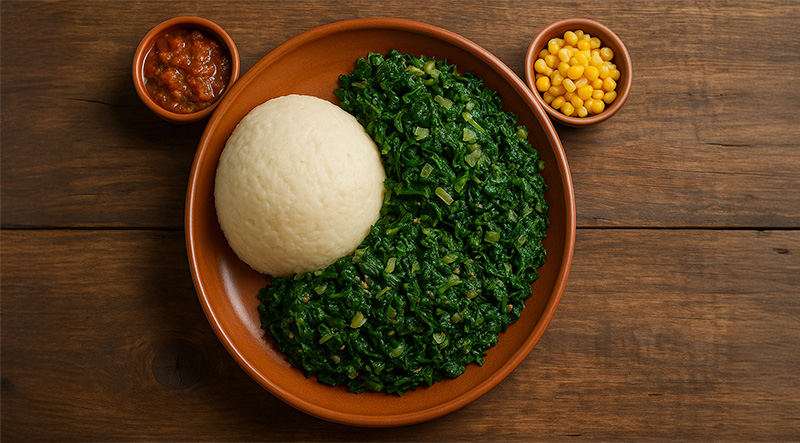The essence of Lesotho on a plate is Papa with Moroho, a hearty, wholesome, and culturally rich dish. Smooth, comforting maize porridge (papa) and savory sautéed leafy greens (moroho) combine to create this well-loved national dish, which has a straightforward but filling flavor that uplifts the soul and body. Papa with Moroho is a delectable celebration of tradition, tenacity, and the rich agricultural heritage of the Basotho people, whether it is served at family dinners or joyous village get-togethers. Read More...
The History of Lesotho’s National Dish – Papa with Moroho:
Nestled high in the mountains of Southern Africa, the Kingdom of Lesotho has a rich culinary heritage that reflects its rugged landscape and agricultural traditions. At the heart of this cuisine lies its national dish: Papa with Moroho—a humble, nourishing combination of maize porridge (papa) and leafy greens (moroho). Though simple in ingredients, this dish holds deep cultural significance, rooted in centuries of Basotho history and daily life.
The Roots of Papa:
Papa is a thick porridge made from maize meal (cornmeal), closely related to dishes like sadza in Zimbabwe, nsima in Malawi, and ugali in Kenya. Maize, though not native to Africa, was introduced through European trade in the 16th and 17th centuries and quickly became a staple across southern Africa due to its adaptability and high yield.
In Lesotho, maize became the dominant grain, replacing indigenous crops like sorghum in many households. Papa is prepared by cooking maize meal in water, stirring continuously until it reaches a dense, smooth consistency. It is filling, affordable, and versatile, forming the foundation of most Basotho meals.
The Significance of Moroho:
Moroho refers broadly to leafy green vegetables, including spinach, cabbage, mustard greens, or locally foraged wild greens. These are typically sautéed with onions, tomatoes, and sometimes seasoned with chili or salt for extra flavor. In a country where access to diverse foods can be limited—especially in rural highland areas—moroho provides vital nutrients, fiber, and flavor.
Traditionally, families grow moroho in small gardens or gather it from the wild, making it both a nutritional necessity and a connection to the land. It represents self-sufficiency, sustainability, and respect for what nature provides.
A Dish of Community and Resilience:
Papa with Moroho is more than a meal—it is a symbol of identity and unity among the Basotho people. It is eaten across all social classes and age groups, served during communal gatherings, funerals, ceremonies, and everyday dinners. For many, it evokes memories of home, family, and togetherness.
In the mountain villages of Lesotho, meals are often shared communally, with papa at the center of the table and moroho ladled on top or on the side. The dish embodies hospitality, simplicity, and nourishment, and serves as a reflection of the country’s values: humility, resilience, and community strength.
The Legacy Today:
Today, Papa with Moroho continues to be a cornerstone of the Basotho diet, whether served on its own or alongside stews like beef, chicken, or beans. It is taught in schools, passed down in families, and prepared in both rural homes and modern restaurants. As Lesotho seeks to preserve its cultural heritage amid globalization, dishes like Papa with Moroho remain a vital link to the past.
Though unpretentious in appearance, this dish is rich in history, nutrition, and meaning—a true taste of Lesotho, rooted in tradition and sustained by the hands of generations.
Cook the Papa (Maize Porridge):
Prepare the Moroho (Greens):

Serve:

Tips:
The total preparation and cooking time for Papa with Moroho is approximately 45 minutes. Preparing the ingredients—washing and chopping the greens, dicing onions and tomatoes, and measuring out maize meal—takes about 10–15 minutes. Cooking the papa (maize porridge) takes an additional 15–20 minutes, depending on the thickness and consistency desired. Meanwhile, the moroho (greens) can be cooked simultaneously, taking about 15 minutes to sauté with onions and tomatoes until tender and flavorful. Altogether, this traditional dish can be prepared efficiently in under an hour, making it both practical and nourishing for everyday meals.
A single serving of Papa with Moroho, based on the traditional recipe, contains approximately 250–350 calories, depending on portion size and ingredients used. The papa (maize meal porridge) provides the bulk of the calories—around 150–200, mainly from carbohydrates. The moroho (leafy greens sautéed with onion and tomato) adds about 80–120 calories, influenced by the amount of oil used during cooking. Optional additions like butter, chili, or extra oil can increase the total slightly. Overall, it’s a wholesome, fiber-rich, and nutrient-dense meal that's low in fat and ideal for a balanced diet.







